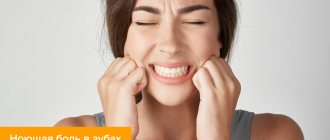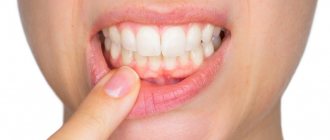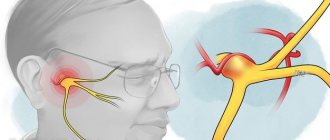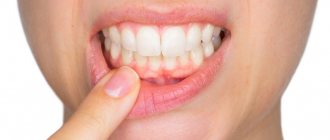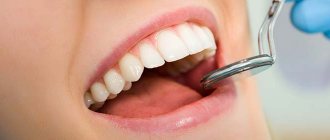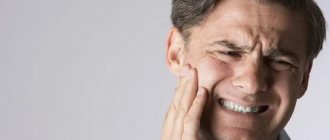The tooth hurts badly. Each of us has had to deal with this unpleasant situation more than once or twice. Many regular patients of the dental clinic already independently differentiate pain due to caries from pain due to pulpitis.
If pain occurs spontaneously, intensely, and worsens at night, they will rush to the dentist the next morning, and if pain arises from external irritants and indicates the development of deep caries, they will allow themselves to postpone treatment for a couple of days. But what to do when all your teeth hurt at once? First, let's figure out why we feel toothache in the first place.
Why is this happening?
The most common causes are the following factors:
- Presence of carious cavities. In this case, pain occurs when eating. Discomfort extends to the entire dentition.
- A cyst localized on the root of a tooth. When it reaches its maximum size, the neoplasm can compress the nerve endings, which is what causes this alarming sign.
- Inflammation of the pulp. In the presence of this dental disease, acute, unbearable radiating pain occurs. The problem is only in one tooth, but it feels like the entire dentition is bothering you.
- Enamel hyperesthesia. We are talking about increased sensitivity of units. When eating foods that are too hot, cold, sour or sweet, a person feels severe pain.
- Trinitarian neuralgia. The most common cause of this symptom. The pain is very piercing; there is a feeling that absolutely the entire lower part of the face, including all the teeth, is bothering.
There are also a number of pathological processes that are not dental. For example, we can talk about ear pain. Discomfort spreads to the jaw, the pain is throbbing and acute. Having eliminated the root cause (that is, inflammation in the ear), pain in the oral cavity will go away on its own; no separate treatment is required.
What is jaw pain like?
Pain in the jaw usually brings very severe discomfort and anxiety.
By nature, they can be acute, sudden, pulsating, or vice versa - aching, chronic, protracted. Often these sensations are so intense that they can even cause a depressed emotional state and depressive disorders [1]. It largely depends on the nature of the pain in the facial area, as well as accompanying symptoms (joint mobility, clicks in it, the presence of swelling, etc.) why the patient’s jaw hurts. During the examination, doctors also pay attention to the localization of sensations - whether they are unilateral or bilateral [1]. It is often difficult to determine exactly whether pain in this area is associated with injury or pathology of the bones, joints, or is caused by some other reason.
Ways to eliminate pain
You need to visit a dentist as soon as possible to identify the specific cause of the discomfort. Self-medication will not be successful; such actions can only lead to the development of complications. At home, you can only reduce pain for a short time in order to wait for a trip to a specialist:
- Painkillers. They will help reduce the manifestation of pain, regardless of what caused the symptom. You can take Nise or Ketarol according to the instructions. If there is nothing suitable, a Paracetamol tablet will do.
- Infusion of chamomile. Pour boiling water over a tablespoon of dry raw materials. When the liquid has cooled, rinse your mouth.
- Soda + salt. Dissolve a teaspoon of salt + baking soda in a glass of warm water. You need to rinse your teeth every two hours.
Diagnostics
To find out what may be causing your jaw pain, you must immediately consult a doctor for diagnosis and appropriate treatment.
List of sources
- Isaykin A.I., Smirnova D.S. Dysfunction of the temporomandibular joint // RMJ. 2022. No. 24. pp. 1750-1755 https://www.rmj.ru/articles/bolevoy_sindrom/Disfunkciya_visochno-nighnechelyustnogo_sustava/#ixzz6EmX7dOtR (access date: 02/23/2020).
- Dentistry. Textbook Aleksandrov M.T., Bazhanov N.N., Medvedev Yu.A., Platonova V.V., Sergeev Yu.N. / Ed. N.N. Bazhanova. - M.: GEOTAR, 2008.
- Gingivitis and Periodontal Disease (Gum Disease) // WebMD Medical Reference Reviewed by Michael Friedman, DDS on March 17, 2019 https://www.webmd.com/oral-health/guide/gingivitis-periodontal-disease#1 (access date : 02/23/2020).
- Fedorova I.N. Bruxism. Unsolved problem. – Moscow, 2009, pp. 1-2.
- Bezzubikova M.V. Dental and somatic manifestations of bruxism syndrome // BMIK. 2022. No. 2. URL: https://cyberleninka.ru/article/n/stomatologicheskie-i-somaticheskie-proyavleniya-sindroma-bruksizma (date of access: 01/31/2020).
- Why Your Jaw Hurts // WebMD Medical Reference Reviewed by Alfred D. Wyatt Jr., DMD on March 21, 2022. https://www.webmd.com/oral-health/why-your-jaw-hurts#1 (date access: 01/30/2020).
- Gaifullina R.F., Kim Z.F. and others. Infarction-like myocarditis: difficulties and solutions in diagnosis // Bulletin of modern clinical medicine. 2022. No. 1. URL: https://cyberleninka.ru/article/n/infarktopodobnyy-miokardit-trudnosti-i-puti-resheniya-v-diagnostike (date of access: 02/23/2020).
Preventive actions
To reduce the risk of dental diseases, you should follow these rules:
- Brush your teeth twice a day.
- Visit the dentist twice a year.
- Preventative professional cleaning of units once a year.
- Avoiding foods that are too hot or cold.
- Carry out enamel whitening only in trusted dental centers.
- Treat your teeth in a timely manner.
- Be more attentive to your health and avoid complications such as otitis media.
- Get rid of bad habits.
- Choose a paste without abrasive particles.
- Additionally, use an antibacterial mouthwash, dental floss and irrigator.
What can you do if all your teeth hurt at once?
It is important to understand that you cannot endure severe pain, especially in all teeth at once. If you experience discomfort, you should visit the nearest dental clinic as soon as possible and undergo an examination. Under no circumstances should you take strong painkillers for a long period of time, especially without a doctor’s prescription.
If you neglect your health, the consequences can be irreversible and very serious. Experts do not recommend applying hot compresses to the sore spot, as increased blood circulation can lead to even more unpleasant sensations.
To alleviate your condition a little before going to the clinic, you can rinse your mouth with a soda solution. It is also allowed to take 1-2 tablets of the most common painkiller, for example, analgin. Before purchasing, you should definitely consult with the seller; most likely, he will be able to suggest the most suitable drug.
previous post
What to do if a tooth is overgrown with gum?
next entry
How to act, which doctor to contact
If you undergo preventive examinations in a timely manner, have recently been to the dentist, had teeth treated and removed, have fillings, dentures and braces installed, then it is recommended to wait for a while and observe your condition. Usually the pain subsides a few days after medical procedures. If after 3-5 days they become stronger, then be sure to consult your doctor again.
Haven't you visited the dental clinic for a long time? Then, most likely, pain that spreads not only to damaged teeth, but also throughout the entire jaw, is associated with advanced caries, pulpitis and periodontitis, as well as other dental pathologies. Be sure to make an appointment and get tested. You may need to visit not only a general dentist, but also an orthopedist, orthodontist, and periodontist.
In what situations should you start an examination not with a dentist, but with a therapist or other doctors with a narrow focus (for example, a cardiologist, neurologist, psychologist, oncologist)? This should be done if, in addition to toothache and discomfort in the jaw, you have a stuffy nose, a sore throat, headache, ears, chest pain, a runny nose and cough, you are experiencing overload and severe stress, and you have noticed the appearance of strange growths and tumors.
Notice
: Undefined variable: post_id in
/home/c/ch75405/public_html/wp-content/themes/UltraSmile/single-item.php
on line
45 Notice
: Undefined variable: full in
/home/c/ch75405/public_html/wp-content /themes/UltraSmile/single-item.php
on line
46
Rate this article:
( 2 ratings, average: 5.00 out of 5)
toothache
- Meyer G., Bernhardt O., Asselmeyer T. Occlusal disorders of teeth as a decisive factor in the occurrence of headaches // Problems of dentistry, – 2013.
Expert “Obsessive pain in any part of the jaw, gums and teeth is a symptom of pathology. Of course, you can temporarily suppress it with the help of drugs from your home medicine cabinet, reduce it with soda-salt solution and chamomile decoction, but such methods will not get rid of the disease that caused discomfort. Therefore, seeing a doctor is mandatory.” Dental hygienist Victoria Nikolaevna Kashaeva
Consulting specialist
Varlamova Tatyana Vitalievna
Specialization: Dentist-therapist Experience: 6 years
Aching teeth: causes of pathology
When a patient comes to see a dentist and asks why his teeth are hurting for no reason, every good doctor will answer that this does not happen. There are always reasons. Any dental problem has its roots, and aching pain in the teeth is no exception. Another point is that the causes of this symptom are quite extensive and can be associated with a number of characteristics of the body and disturbances in the functioning of its systems. Experts identify more than a dozen factors that can cause aching pain in the teeth.
- Congenital hyperesthesia.
Increased sensitivity of enamel can be inherited, which is why a person may experience discomfort when exposed to temperature and chemicals. - Chips, cracks and other damage to the enamel.
Tooth injuries lead to dentin exposure and also facilitate the penetration of pathogenic microorganisms. - Thinning and weakening of enamel.
This can happen for several reasons. First of all, due to a lack of vitamins and minerals. The second common reason is weakening of the enamel as a result of frequent whitening procedures. - Caries and its complications.
Typically, aching pain in the teeth occurs in the middle stages of the disease. - Periodontal diseases in the active stage.
With periodontitis and periodontal disease, the necks of the teeth are exposed, which makes them (and surrounding tissues) very sensitive to irritants. The same applies to the wedge-shaped defect. - Infectious diseases,
especially chronic ones. Influenza, sinusitis, sinusitis - these diseases can sometimes provoke aching pain in the teeth and jaw. - Problems with the gastrointestinal tract.
- Stress, fatigue, lack of sleep.
- Hormonal disbalance.
Often, aching pain in the teeth occurs during pregnancy. - Inflammation of the trigeminal nerve,
when the pain “radiates” to the teeth. - Allergic reaction
to medications.
Comments
Recently, pain appeared in the lower tooth, which is covered with a crown. Now my lower jaw is also aching, but I’m very afraid to go to the doctor. Will this tooth be removed immediately?
Vika (01/14/2021 at 00:41) Reply to comment
- Dear Vika, seeing a doctor as soon as possible can be the key to saving the tooth that is under the crown. Yes, if an inflammatory process has formed on the root, for example, periodontitis or a cyst, then in order to access the canals, in most cases the artificial crown will have to be removed, and after treatment a new one will have to be installed, but the main thing is that the tooth can be saved.
Editorial staff of the portal UltraSmile.ru (01/16/2021 at 09:01) Reply to comment
In the lower jaw, on some teeth, the gums seem to have decreased and in fact they have become bare. How to grow gum back into these places and is it possible? What medicinal and traditional methods of treatment exist?
Julia (02/05/2021 at 08:44) Reply to comment
I know about caries and pulpitis firsthand! You cure one tooth, another begins to crumble ((I would like to know what needs to be done so that they do not collapse one after another!? This is a disaster!
Marina (02/05/2021 at 09:21) Reply to comment
I had a tooth removed and a purulent sac was found in it. More than a year has passed since the tooth was removed, but the pain in that place does not go away. I have never seen redness or swelling on the gums. Tell me, what could be the reason?
Anna (02/05/2021 at 09:46) Reply to comment
When I have a sore throat, I often feel like all my teeth hurt. And my jaw just hurts like crazy, and it radiates into my ear. I can’t live without painkillers. Is it dental problems? Or do you need the help of an ENT specialist here?
Anetochka (03/04/2021 at 10:29) Reply to comment
I have small ulcers on the inside of my cheeks that are bleeding. I thought it was stomatitis and rinsed my mouth with a soda solution, but it had no effect. What could it be? Isn't this cancer?
Stepan Viktorovich (03/04/2021 at 10:34) Reply to comment
it turns out that the problem can be serious, but it would seem to be nothing of the kind; someone might even think that it was just a leak. can this problem be treated as an emergency?
Marina (03/04/2021 at 10:40) Reply to comment
Write your comment Cancel reply
Prevention of aching teeth
The best way to prevent an unpleasant symptom is to follow preventive measures. Despite the fact that the enamel itself is very strong, improper lifestyle and exposure to the external environment gradually weaken and destroy it. If you have sensitive enamel, you need to carefully choose hygiene products. In particular, it is recommended to avoid hard toothbrushes and use toothpastes with calcium and fluoride. An equally important point is the right diet. It is necessary to reduce the consumption of spicy, sour and sweet foods to a minimum, and give preference to fermented milk products and foods high in vitamins A and B. Temperature changes are a big stress for sensitive enamel, so the best solution is to drink drinks at room temperature.
Publisher: Expert magazine about dentistry Startsmile.ru
Author of the material: Yaroslav Ikonnikov
How to treat arthrosis of the jaw?
Treatment for arthrosis of the jaw joint varies depending on the causes of the disease. Its purpose is:
- restoration of mobility of the lower jaw;
- suppression of degenerative and dystrophic processes in the joint.
As a rule, the doctor prescribes analgesics and recommends wearing a splint - an elastic, removable mouth guard that distributes the load on the jaw. The selection of an individual splint (based on an impression), palatal plate or other orthodontic device for arthrosis of the jaw joint is carried out for relaxation in case of muscle hypertonicity or maintaining a healthy position of the TMJ. If the splint is not enough, a specialist may prescribe a Botox injection. Then permanent dentures are created for the patient, which help support the joint affected by arthrosis and correct the bite. Also, with arthrosis of the lower jaw, selective grinding of teeth can be performed.
Treatment of arthrosis of the jaw joint involves a moderate change in habits. Patients should avoid eating solid foods, frequent vocal exercises, and chewing gum. Therapy for arthrosis of the jaw joint requires lifelong limitation of mechanical loads and regular visits to the dentist or gnathologist. Preventive courses of physical and pharmacotherapy are carried out at least 2 times a year. It is important to minimize stress and physical strain. The further the disease progresses, the softer the food should be - until the patient switches to purees, cereals, soups and juices.
It is considered optimal to start treatment at stage 1 or 2. In advanced cases of arthrosis of the jaw joint, only surgical intervention can help the patient.
Osteoarthritis of the jaw joint - which doctor should I contact?
The first step if you suspect arthrosis of the jaw is to consult an orthodontist or gnathologist. They will give the patient a referral for an x-ray, and will also determine whether there are any malocclusions or dental contact problems. You may also need to consult a prosthodontist.
If the cause of the disease is primary diseases, in parallel with a specialized doctor, narrow specialists participate in the treatment of jaw arthrosis - for example, a rheumatologist, endocrinologist, neurologist, psychotherapist or otolaryngologist.
Drug treatment of jaw arthrosis
Treatment of arthrosis of the jaw joint with medications is usually carried out in a hospital setting. At home, patients can take painkillers, use warming and analgesic local drugs, and also take chondroprotectors.
To relieve inflammation and improve jaw mobility, patients take non-steroidal anti-inflammatory drugs (NSAIDs) intravenously or orally - for example, ketoprofen, ibuprofen, paracetamol, nimesulide. For topical use, ointments and gels are recommended - finalgon, nicoflex, voltaren, butadione and indomethacin. In the absence of allergies, preparations based on medical bile and bee venom are used. Muscle relaxants, such as mydocalm, help relieve spasm in arthrosis of the jaw joint.
For severe pain, in addition to glucocorticosteroids (hydrocortisone), injections of opioid analgesics are prescribed - for example, tramadol, trimeperidine.
If there are injuries or foci of infection in the body, treatment of arthrosis of the jaw joint is accompanied by antibiotic therapy in the form of injections of cefazolin, metronidazole, cefuroxime.
For better regeneration of cartilage and synovial fluid, it is recommended to take chondroprotectors - for example, artracam, Dona or Movex.
Drug therapy for arthrosis of the jaw joint is carried out 2-3 times a year as prescribed by a doctor. The administration of drugs is often combined with physiotherapeutic techniques - for example, in the form of electrophoresis with novocaine, lidase and iodine, Trilon ointment.
Physiotherapy in the treatment of jaw arthrosis
Physiotherapy in combination with properly selected medications and orthodontic devices helps eliminate pain without surgery, even at the 3rd stage of arthrosis. Therefore, the following physiotherapeutic techniques are used to treat arthrosis of the jaw joint and rehabilitate patients.
- ultrasound (10-20 sessions);
- laser therapy (14 sessions);
- microwave therapy (UHF - 10-12 sessions);
- electrophoresis (10-12 sessions);
- phonophoresis;
- mud therapy;
- myogymnastics;
- massage of masticatory muscles;
- balneotherapy (including paraffin therapy and ozokerite);
These procedures improve nutrition of the affected joint, normalize metabolism and activate the processes of natural regeneration of bone and cartilage tissue. With fibrotic changes in tissues, physical therapy helps to soften them and increase the range of motion of the jaw. Also, this type of treatment relieves inflammation, has an analgesic effect and serves to prevent complications of arthrosis of the jaw joint.
Therapeutic exercise for arthrosis of the jaw joint
Therapeutic exercises for arthrosis of the lower jaw help maintain facial mobility, speech intelligibility, improve innervation of the affected area and reduce the impact of the disease on other organs and systems. With hypertonicity of the masticatory muscles, it helps to stretch the ligaments and relax the jaw, and also strengthens the jaw apparatus. This promotes proper distribution of the load, and therefore slows down the progression and reduces the symptoms of arthrosis of the jaw joint. Myogymnastics does not replace wearing a mouthguard, but significantly enhances its effect.
- Press your tongue against the hard palate and allow your jaw to drop freely as you relax the muscles in your lower face.
- Place your thumb on the affected joint (in front of your ear) and, keeping your tongue against the roof of your mouth, place your index finger on your chin. Lower your jaw halfway, overcoming the gentle resistance of your index finger. Shut your mouth. Repeat 6 times, and then begin to lower your jaw completely (also 6 times).
- Raising your shoulders and chest, tuck your chin in so that a “double chin” forms under it. Hold for 3 seconds, then repeat (10 times).
- Place your thumb under your chin and gradually open your mouth completely, against the gentle resistance of your finger. Then grab your chin with your thumb and index finger and repeat the exercise - this time closing your mouth (10 times).
- With the tip of your tongue in the center of your palate, open and close your mouth.
- Grasp a small object with your front teeth and slowly move your jaw from side to side. Then repeat the exercise with back and forth movements. As your range improves and the exercise becomes easier, increase the thickness of the object.
Wisdom tooth and bite
Due to incorrectly positioned figure eights, traumatic nodes are formed in the bite. They lead to overstrain of the chewing muscles and problems with the TMJ. From processing, articular cartilage wears off and changes. Chronic inflammation appears in the joints, manifested by clicking and painful sensations. In severe pathologies, a violation of the lower jaw leads to the inability to open the mouth. Therefore, treatment of TMJ teeth begins with the study of the wisdom tooth and bite. Dentists carry out functional diagnostics, during which the movement of the jaws relative to each other is determined. Assess how wisdom teeth affect your bite. If interference is detected, units are removed. It also eliminates malocclusion if it already exists.
